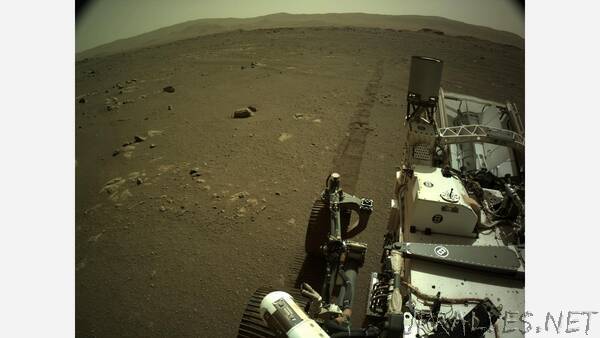
“After the Perseverance rover’s landing on Mars, the world marveled at the remarkable new images from the planet’s surface.
Earthlings can’t get enough of the Red Planet. And unbeknownst to most — even to some of the engineers who’ve been involved (more on that later) — NASA’s Mars 2020 Perseverance rover contains a vital piece of Intel-based tech that’s helping get these images beamed back to us.
After traveling 293 million miles from Earth, the Perseverance spacecraft plummeted at 10,000 mph (16,000 kph) into the thin Martian atmosphere on Feb. 18, 2021. It deployed a 70-foot-wide red-striped parachute, slowed to 200 mph (320 kph), fired its eight hydrazine descent engines — and stuck the landing.
We all saw the video: Hovering about 66 feet (20 meters) above Jezero Crater, the descent stage’s sky crane gently winched the 1-ton (Earth weight) Perseverance rover down onto the surface of the Red Planet.
“Well, we were very proud. We told everyone the great news,” said Yuval Sela in a recent interview from south of Haifa, Israel.
Sela’s firm, Israel-based CompuLab, provided NASA with a pair of COMEX-IE38s — essential credit-card-size computing modules that enable Perseverance to store and send its eye-popping photos and videos to Earth. The module is powered by an Intel Atom® (“BayTrail”) processor-based system running Linux.
“It’s a very good feeling that someone so important has confidence in a product that we’ve made,” said Sela, a CompuLab vice president.
Even though teams from NASA and its Jet Propulsion Laboratory are the lead aerospace engineers on the Mars 2020 mission — and cheered the landing in mission control — smaller, lesser-known teams are also basking quietly in the mission’s success.
“The Perseverance Mars story is an amazing story,” says Maayan Ronen, Intel Israel’s Internet of Things sales lead. “This is like changing the reality we live in. Sci-fi movies are coming to life.”
And that device that’s helping Earthlings see Mars is literally an off-the-shelf product. If you walked up to CompuLab’s offices, they’d sell you one for about $150.
Ronen estimates that CompuLab has bought tens of thousands of Intel Atom processors in recent years to create its COMEX-IE38 modules, which are now operating around the world in everything from medical equipment to industrial machines to oil rigs.
All the photographs and videos coming Mars — that famous descent and now the boulder-strewn landscapes with evidence aplenty of Mars’ watery past — are handled by a pair of data storage units, or DSUs. Each DSU is powered by one of the Atom-based COMEX-IE38 modules. One DSU is tucked inside the belly of the Perseverance rover, the other was aboard the descent stage, which flung itself onto the Martian surface, about 1,000 meters away, about two minutes after its winching work was done.
The Perseverance rover is outfitted with 23 cameras. Data from each of the cameras is fed in raw format to the DSU via Ethernet link, then compressed by the COMEX-IE38 module and saved to a 480GB solid-state drive for uplink back to NASA engineers on Earth. (Read the full tech specs and details.)
Electrical power is at a premium when you’re parked at an out-of-way place like the surface of Mars. Ronen explains that’s the reason a power-sipping processor like the Intel Atom is ideal. Plus, there’s the crazy-thin Martian atmosphere — 99.4% less dense than Earth’s, or the equivalent of being 22 miles above our planet.
“The density of the atmosphere is so low, the heat dissipation is much harder,” says Ronen. Another reason why a chip that produces a scant amount of heat is a good thing.
Were Ronen and Sela waiting for the last seven months since launch with bated breath? Quite the opposite. They knew NASA had bought a couple of COMEX-IE38s. But that was it. Not until they read the NASA tech reports shortly after the landing did they know they were even aboard.
Says Sela, laughing, “We had no idea.””
